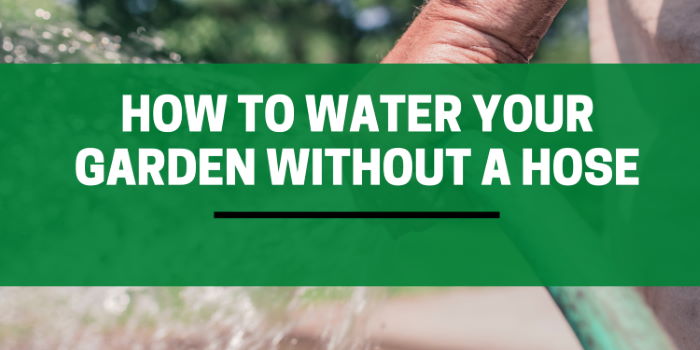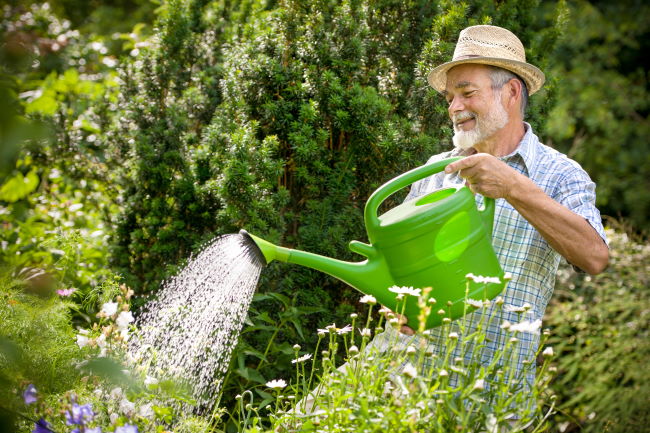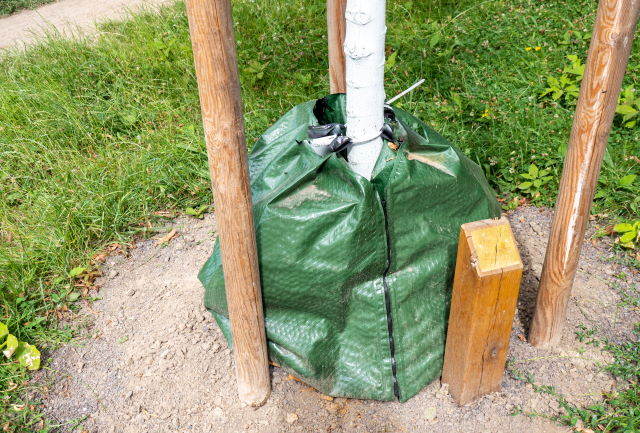
As a gardener, I know the importance of watering my plants. Watering is vital to plant health and growth, but sometimes, using a hose can be impractical or even impossible.
Whether you are facing water restrictions, a lack of access to a garden hose, or simply want to try something different, there are several ways to properly water your garden without a hose.
In this article, I will discuss different methods and techniques for watering your garden that doesn’t involve a hose.
Contents
Why Water Your Garden Without A Hose?
While hosepipes have long been a go-to tool for gardeners, there are plenty of good reasons why it’s OK to ditch the garden hose and try out some alternative watering methods. Here are just a few:
Conserve Water
Did you know that a hosepipe can use up to 1,000 liters of water per hour? That’s a hefty amount especially if you water regularly. It’s not exactly environmentally friendly either.
By switching to a more efficient watering method, such as a watering can or a drip irrigation system, you can save water and reduce your water bill. A rain gutter downspout can also be great for water conservation.
Save Time
Hosepipes can be time-consuming to set up and use, especially if you have a large garden or multiple plants to water. If you have a small garden, setting up a hose may not be worth the time.
Using a watering can or a drip irrigation system can be much quicker and easier. This kind of system or soaker hoses are run for a period of time, allowing you to spend more time enjoying your garden and less time wrestling with a watering wand.
Better For Your Plants
Hosepipes can give out water at quite a high force. This water pressure can damage delicate plants or wash away nutrient-rich soil. They can also disturb the soil of container plants.
By using a watering can or a drip irrigation system, you can apply water more gently and accurately, ensuring that your plants get the right amount of water without the risk of damaging them.
More Flexibility
Hosepipes are often limited by their length, meaning that you may not be able to reach every part of your garden. With a watering can or a drip irrigation system, you have much more flexibility to water your plants wherever they may be.
More Sustainable
I am always looking for ways to reduce my environmental impact and live more sustainably. By ditching the hosepipe and trying out alternative watering methods, you can reduce your water usage, save energy, and reduce your water wastage.
So, if you’re looking for a way to make your gardening routine more efficient, sustainable, and enjoyable, why not give up the hosepipe and try out some alternative watering methods? Your plants (and your water bill) will thank you!
Techniques for Watering Your Garden Without a Hose
Watering Can
One of the most traditional and straightforward methods of watering your garden is to use a watering can.

A watering can will allow you to apply water directly to the soil around the plant’s base, ensuring that the water reaches the plant’s roots. Watering cans come in various sizes and shapes, and some even come with a long spout for reaching plants in hard-to-reach areas.
When applying water with a watering can, be sure to pour the water slowly and directly onto the soil.
Drip Irrigation
A drip irrigation system delivers water directly to a plant’s roots through a series of soaker hoses and emitters. This can be particularly useful for sandy soil that dries out quickly or for plants that require evenly moist soil. if you live in a part of the world which often has drought conditions, drip irrigation can be a great choice.
This method is highly efficient because it delivers water right where it’s needed, reducing water waste and minimizing evaporation. Drip irrigation systems can be purchased at garden centers or online, and they are relatively easy to install.
Once installed, drip irrigation systems can be programmed to water your garden at specific times and for specific durations, making them a convenient and time-saving option.
Sprinklers
Sprinklers are a popular method for watering a garden. They are often used for lawns as they are easy to set up and can cover large areas. They do technically use a hose, but without manual spraying required.
When using sprinklers, it’s essential to choose the correct right type and position. Some sprinklers produce a fine mist, which can be perfect for delicate plants or seedlings. Other sprinklers produce a more substantial spray and are better suited for established plants and lawns.
Try to place a sprinkler in a location that will cover the entire garden area and adjust the water pressure to ensure the water reaches the soil and not just the leaves.
Watering Bags
Watering bags are an innovative way to water trees and shrubs without a hose. These bags wrap around the plant’s base and slowly release water over several hours or days, ensuring that the water consistently reaches the roots.

Watering bags are particularly useful for newly planted trees or shrubs that need regular watering to become established. They are also ideal for locations where water is scarce or restricted.
Bucket or Tub
Using a bucket or tub is a simple and effective method for watering small gardens or plants. Fill a bucket or tub with water, and use a smaller container, such as a cup or ladle, to pour the water directly onto the soil around the plants.
This method works well for plants that need to be watered deeply, such as tomatoes or peppers.
Tips for Properly Watering Your Garden Without A Hose
No matter which method you choose for watering your garden, there are some essential tips to keep in mind.
Water Deeply
When you water your garden, make sure to water deeply, so the water reaches the plant’s roots. Shallow watering can lead to shallow root growth so roots don’t go deep in search of moisture. This makes plants more susceptible to drought and stress.
Deep watering also encourages plants to develop deeper roots, which can help them better access nutrients and moisture.
Water At The right time
Watering at the right time of day can help minimize water waste and ensure that plants receive the moisture they need. The best time to water your garden is in the early morning or late afternoon when temperatures are cooler, and there is less evaporation.
Avoid watering during the middle of the day when the sun is highest and temperatures are hottest. This can cause the water to evaporate before it reaches the soil. Water droplets on leaves during hot weather can cause a burning effect.
Also try to avoid evening watering as any moisture left overnight can lead to a soggy garden bed or mold growth. Wet leaves left overnight can cause leaf disease.
Water Consistently
Consistent watering is key when it comes to your garden. It’s essential to water regularly, so plants receive a consistent amount of moisture.
Depending on your location and climate, you may need to water your garden daily or every few days. Clay soil and loamy soil hold moisture longer while sandy soil dries out quicker. So check the soil type and soil conditions regularly to determine a proper watering schedule.
If the soil feels dry to the touch, it’s time to water. A water gauge or rain gauge can be useful to see if an area of your garden has received enough water.
Remember that pots hold heat so the potted plant soil dries out quicker than normal garden soil.
Use The Correct Amount Of Water
Using the right amount of water is crucial to plant health. Over-watering can lead to waterlogged soil, which can suffocate plant roots and cause rot. Yellow or black leaves can be a sign of this as roots become under-aired.
Underwatering can cause plants to become stressed and wilted. As a general rule, most plants need about an inch of water per week. However, this can vary depending on the plant’s type, size, and location.
Mulch Your Garden
Mulching your garden can help retain moisture and nutrients. Mulch also helps regulate soil temperature and suppresses weed growth.
Add a layer of organic mulch, such as leaves, grass clippings, or shredded bark, around your plants to help them retain moisture.
Conclusion
Watering consistently is critical to plant health and development, but it doesn’t need to involve a hose. Whether you use a watering can, drip irrigation, sprinklers, watering bags, or a just bucket, there are many ways to properly water your garden without using a hose.
Remember to water deeply, water at the right time, water consistently, use the right amount of water, and mulch your garden to help your plants thrive.
FAQs
Can I use a spray bottle to water my garden?
Yes, you can use a spray bottle to water small plants or seedlings. However, it may not be practical for larger gardens or established plants.
How often should I water my garden?
This depends on your location and climate. Generally, plants need about an inch of water per week, but this can vary depending on the plant’s type, size, and location.
Can I use rainwater to water my garden?
Yes, using rainwater to water your garden is an excellent way to conserve water and provide your plants with natural nutrients.
What’s the best way to water newly planted trees or shrubs?
Using a watering bag is an excellent way to water newly planted trees or shrubs. Watering bags wrap around the plant’s base and slowly release water over several hours or days, ensuring that the water reaches the roots.
Can I water my garden at night?
It’s best to avoid watering your garden at night, as this can lead to fungal growth and disease. The best time to water your garden is in the early morning or late afternoon when temperatures are cooler.
